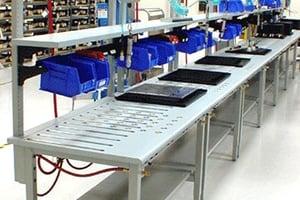As manufacturing processes become more advanced and diverse, industrial tables play a crucial role in facilitating efficiency and safety.
Gone are the days when a slab and four legs was sufficient. Now, companies across several industries need to consider employee health, adaptability and technology when choosing workspaces. Manufacturers, laboratories, research facilities and production plants are all turning to the industrial table of today to meet these evolving needs.
Here are some ways the industrial table is adapting to these changing conditions.
Integration Of Technology
The integration of technology in industrial tables is revolutionizing manufacturing spaces, paving the way for increased efficiency, data-driven decision-making and streamlined processes.
for increased efficiency, data-driven decision-making and streamlined processes.
An industrial table can be designed to serve as a hub for connecting electronic devices and machinery seamlessly. Built-in power outlets, USB ports and data connections provide easy access to electricity and data transfer, eliminating the need for external power sources and reducing cable clutter. This smart connectivity simplifies the setup of equipment and enables a more organized and efficient workspace.
In manufacturing environments where electronic devices are used extensively, industrial tables with built-in wireless charging pads and dedicated charging compartments ensure that tools and devices remain charged and ready for use. Some tables are even equipped with battery management systems to optimize charging and extend battery life.
Industrial tables can also be designed to support automation technologies and collaborative robots (cobots). They provide convenient docking stations or mounting points for robotic arms and peripherals, ensuring the safe interaction between human operators and automated systems.
By integrating technology, industrial tables have become much more than just static work surfaces. They now act as central hubs, and as technology continues to advance, industrial tables will likely play an increasingly integral role in driving the factories of the future.
A Focus On Worker Safety
Data from the U.S. Bureau of Labor Statistics show that sprains, strains and tears are collectively the leading type of injury in manufacturing. Nearly 32% of nonfatal injuries resulting in days away from work were treated in emergency rooms. A vast majority of nonfatal workplace injuries, whether they resulted in emergency room visits or not, were musculoskeletal injuries, also known as ergonomic injuries.
The well-being of workers is a top priority in modern manufacturing spaces. Yet ergonomic injuries are still occuring. Ergonomic injuries result from the strain and stress placed on the musculoskeletal system due to repetitive, forceful or awkward movements and postures.
These injuries often occur with jobs that involve repetitive tasks, heavy lifting or prolonged periods of sitting or standing in uncomfortable positions. Ergonomic injuries can impact various parts of the body, including muscles, tendons, ligaments, nerves and joints.
Some of the most common injuries include:
- Carpal tunnel syndrome
- Tendinitis
- Rotator cuff injuries
- Lower back pain
- Neck strain
- Epicondylitis (tennis elbow/golfer’s elbow)
- Trigger finger (inflamed finger’s tendon)
- Thoracic outlet syndrome (compression of nerves or blood vessels)
- De Quervain’s Tenosynovitis (inflammation of the tendons at the base of the thumb)
Many modern-day industrial tables are built with ergonomics in mind, ensuring proper height, easy access to tools and reduced strain on workers’ bodies. Designers accomplish this by:
- Adding accessories like monitor arms that position computer monitors and other supplies at a comfortable level
- Including anti-fatigue surfaces that reduce pressure on the feet, legs and lower back
- Allowing workers to adjust the height of the table legs
- Adding industrial furniture chairs that promote comfort and better posture
- Incorporating rounded or contoured table edges and corners that reduce pressure on forearms and wrists
- Providing ample legroom and footrest options to prevent stiffness and discomfort
- Incorporating anti-slip and stability features that help prevent accidental slips or falls that could result in injuries
By including these design features, modern industrial tables are taking significant steps toward mitigating ergonomic injuries in manufacturing and laboratory spaces.
ESD Compliance At The Forefront
As electronics have evolved, so have problems associated with static electricity. And as electronic devices have become faster and the circuitry smaller, the sensitivity to electrostatic discharges (ESD) has increased. According to the ESD Association, there is growing evidence that this trend may be accelerating.
The EOS/ESD Association’s Electrostatic Discharge (ESD) Technology Roadmap is revised every few years and says, “With devices becoming more sensitive, it is imperative that companies begin to scrutinize the ESD capabilities of their handling processes.”
Electrostatic discharge occurs when two objects rub together and one object gives up electrons to another object. This causes one to become more positively charged while the other object becomes more negatively charged, creating a charge imbalance once the two materials or products separate.
These charges then may build up on an object’s surface until they find a way to be discharged. In industrial workspaces and laboratories, static electricity can interfere with weighing accuracy, cleanroom specifications and safety requirements.
Many different types of businesses can have issues with ESD, from pharmaceutical to agriculture, printing and graphic arts, plastics and electronics manufacturers. But how can an industrial table help offset this concern in these industries?
Work tables that feature ESD laminate surfaces can help dissipate any static that is generated. Made of high pressure laminate with a carbon layer, this work surface provides other benefits as well, such as resistance to staining and chemicals that include acetone, gasoline and 10% ammonium solutions.
Depending on your electrostatic discharge concerns, you may also need an ESD chair, which is manufactured with high-quality non-flammable ESD fabrics and vinyls.
Mobility For Greater Flexibility
It’s common for workspaces to change layouts to better optimize floor space as needs and goals change. A mobile industrial workbench or table is the perfect solution to adapting to changing needs in manufacturing spaces.
mobile industrial workbench or table is the perfect solution to adapting to changing needs in manufacturing spaces.
Some models have casters or wheels, making them easy to move and reconfigure to suit evolving production needs.
If you have a heavy duty industrial table, it’s important to ensure your casters will adequately support that weight. Look for quality casters that are of a higher standard and have a weight load capacity of around 1,000 pounds when all four pieces are in use.
Casters can also affect the work table’s height, so keep that in mind when choosing them, especially if multiple people will be using the industrial table. Other features to look for include whether all four wheels lock, if they can swivel in place when locked or unlocked, and whether they can adjust in height.
A Top For Evolving Lab Needs
Industrial and laboratory settings often continually evolve as new needs arise. Laboratory and manufacturing spaces saw this firsthand during the covid-19 pandemic when testing facilities had to switch direction quickly to accommodate the specific needs of the healthcare community.
Countertop manufacturers have evolved over time as well to meet these changing needs by offering industrial table tops that have higher durability and can withstand the harsh conditions or cleanliness requirements of a workspace.
Some of the most common materials used for industrial table countertops include:
- Phenolic resin
- Epoxy resin
- Stainless steel
- Chemical resistant laminate
- High pressure laminate (HPL)
- ESD laminate
- Butcher block or wood
New applications may be on the horizon for your facility, which is why it’s important to consider the top of your industrial table as well. Consider not only your budget but what chemicals may be used in the future. You may also need a tabletop that will protect your industrial table from abrasive substances, direct heat or moisture.
Our article, Top 5 Materials To Consider For Your Lab Countertops, breaks down some of the most common countertops found in workspaces today so that you can ensure your facility is ready and able to adapt to changing needs as they evolve.


